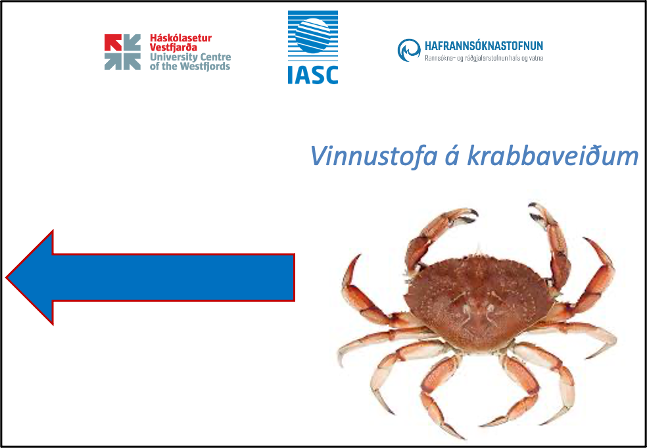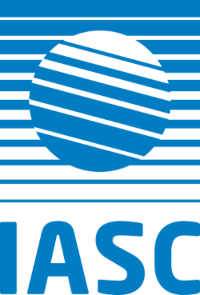How societies tackle changing environmental and social conditions is an important topic in the Arctic sciences, and our workshop tried to carve out a tiny spot in this field by using Icelandic Atlantic rock crab (Cancer irroratus) fisheries as a focal point. This fishery is interesting because the rock crab is a newcomer in Icelandic waters (first found in Hvalfjordur in 2006), originating from the eastern coast of North America. It has already been shown that the abundance of the rock crab’s main native competitors, European green crab (Carcinus maenas) and spider crab (Hyas araneus), have decreased since its establishment (Gíslason et al., 2021).
But what to do with a new species that is also potential invasive? New species like this can be difficult to control, and crabs are some of the highest-value seafood products, so there were natural questions regarding if this species would become a fishery in Iceland. Rock crab in the U.S./Canada is caught in traps by small-scale vessels and therefore a potential rock crab fishery could be beneficial to small-scale fishers and rural communities. In Iceland many coastal communities developed in close proximity to historically important fishing grounds. Over time, there have been several negative impacts on coastal communities, most notably quota concentration and shrinkage of the small-scale fishery sector leading to rural depopulation. Other factors that compromise the small-scale fishery and therefore the livelihoods of coastal communities include aging of the fishing sector as well as limited access, and environmental changes (Kourantidou & Kaiser, 2021; Gislaason et al., 2021). In this way, the rock crab fishery in Iceland is comparable to other Arctic coastal communities looking for sustainable community development options in changing ocean conditions.
Currently, the Icelandic rock crab catches have slowly increased from less than 10 tonnes annually prior to 2020, when they reached 22 tonnes (Fiskistofa, 2022). The expectation is, however, that catches may reach 500 to 1000 tons throughout the next couple of years (Guðmundsson, 2022a). By organising a workshop with small scale fishers, researchers and processors, we aimed to understand how the knowledge and experience of small-scale fishers in several geographically disparate coastal communities could be taken into consideration for development of the fishery. We also aimed to assess the potential for crab fishing to become a viable supplement or mainstay to the livelihoods of fishers in small rural communities around Iceland.
The workshop was held in Hafnarfjörður, Iceland, on 19 October 2023 (Figure 1). The agenda consisted of knowledge sharing among fishers, experience from processing and options for community development, learning from international experience, exploring what is known biologically, and innovations in boat design, marketing, and export (Appendix 1). A special highlight is that ECR Jón Magnússon held his first presentation in Icelandic regarding his masters research on the biological impacts of the rock crab (Figure 2), congratulations Jón! In total, 29 people participated in the workshop, from different sectors (8 fishers, 2 participants working in the processing industry, a representative of the small boat owner association, a boat manufacturer, 8 researchers, 6 others from local and national government bodies and regional development associations, and the 3 organisers). Workshop participants came from several small towns around Iceland as well as the capital area and the focus of the workshop was on fishers’ experiences. Two online participants joined in to detail the experiences in Norway (Appendix 2).
 |
 |
| Figure 1: Workshop sign: crabs! This way! | Figure 2: Jón Magnússon presenting his masters thesis research |
Highlights
The workshop generated new ideas and collaboration among stakeholders and was very well received by all. Participants expressed satisfaction with the opportunity for dialogue and knowledge sharing among scientists and fishermen. The workshop leveraged experiences from other countries on how to overcome challenges in the crab fishing industry, ensuring sustainability and profitability. It emphasized the need for collaboration, setting regulations, addressing information gaps, expanding markets, considering the environmental impact of crab fisheries and the exchange of information and data to make informed decisions and promote a more sustainable and prosperous crab fishing industry in Iceland.
Participants recognized the need to set limits and regulations for crab fishing vessels. An excessive number of traps could disadvantage especially smaller players and disrupt the ecosystem. Calculations are needed to determine the appropriate number of traps in specific areas to ensure sustainable fishing.
Collaboration between fishermen and researchers is crucial, not only for finding answers but also for formulating research questions. Fishermen acknowledge the importance of listening to scientific advice provided by organizations like the Institute of Marine and Freshwater Research. Understanding the behaviour and ecology of rock crabs and other crab species is essential for effective harvesting and conservation, so researchers should work closely with the fishing industry to address their concerns and improve the sustainability of crab fisheries.
The workshop highlighted the importance of the market's future setting and the need to address market-related challenges (highlighting the economic interests at stake) as well as several key factors that are still unknown (impact on native species, toxins and heavy metal presence in crab meat, etc.). Other challenges include difficulties in selling rock crab and an aging workforce. At the same time, there are real opportunities for the growth of the industry, as evidenced by the experience of the processors and boat manufacturer (Figure 3).

Figure 3: Visit to Trefjar, a small-boat building company that specialized in designs for trap fisheries.
Next steps
In the wrap up session of the workshop, participants ranked what were important topics to move forward with, and what were easy vs hard to proceed with (Figure 4). It's clear that cooperation between researchers and fishermen, sustainable crab harvesting, marketing, and adapting to changing markets and regulations are central concerns in the crab fishing industry. Emphasis could be placed on the significance of storytelling and marketing to make crab products more appealing to consumers as well as the involvement of chef teams and the younger generation in promoting crab products in restaurants, creating new markets in Iceland and Europe. Participants also discussed the collaborative learning opportunities from other countries. How does Norway, the UK, the US, and Canada, manage their crab fisheries? The intention would be to learn from successful practices in these countries and adapt them to the Icelandic context. With leftover funds after the workshop, the results from the workshop will be presented at the Arctic Congress 2024 by an ECR, Sæunn Sigurjónsdóttir, who was also involved in the workshop. Her presentation will also include reflections on the process of the workshop and the importance of these kinds of knowledge exchange activities, which are not common in Iceland.


Figure 4: Wrap up session, after a short crab taste-test of course!
Three scientific highlights in bullets
- Catches for rock crab are good for the moment, with ~30T being fished in 2022. There are differences in total catches based on the type of seabed and bait used. Similarly, there are differences depending on the setting of the traps, the timing and the trap types. A fisherman commented that around 70% of the catch come in during the first night the traps are set out. The problem is that, at the moment, there are a lot of different approaches but no consensus on the best practices (best time of day/year, best types of traps, best areas, etc.) for rock crab harvesting. As an example, one fisherman was using around 20 traps with 30m between them and commented that the first and last traps yielded the maximum catches (probably due to those covering a bigger total area) while another was using less traps and only 12m between them and seemed to yield profitable catches. This sharing of fisher´s knowledge will be important to continue in the future, both among fishers and between fishers and biologists.
- Fishing rock crab was deemed as an expensive and complicated process, with lots of moving parts, and needing lots of manpower. The current price for rock crabs (200ISK/kg) may not cover expenses like traps, bait and fuel. There are also challenges and expenses associated with processing and freezing crabs for commercial use. Concern with high catches leading to “overbooking” in the processing plant which leaves the fishermen with lots of product that cannot be used. The possibility of having multi-species fishing for more profitability was discussed among fishermen. Using the same boats to catch different stocks throughout the year, which is an expensive investment but worth it in other countries (Canada, UK) that have strong rules and regulations on fishing grounds, fishing gears, etc. Nevertheless, there are difficulties to sell rock crab, which was a big concern among the fishermen. The age of fishermen was also mentioned, as newer generations don’t seem to be taking over, leaving fisheries with an aging workforce. Further work is needed both on the economic feasibility for fishing families and coastal communities, and also the regulatory environment around the fisheries management and decision-making.
- Is the rock crab in Iceland an invasive species or a fishable stock? The answer is both. There have been yearly reviews and data collection since 2007. Average crab size in Iceland is 270g and 12.5cm, with larger individuals reaching up to 550g and 15cm, and densities in Iceland are the biggest in the world, even higher than in its natural range. With each year, the rock crab population has been growing, raising concerns about species invasion and the potential impacts on native species. This is an invasive but also marketable species, but there is a need for more basic biological data. Scientific advice and data collection are essential for making informed decisions, and the use of data from other countries for comparison was considered. The workshop emphasized the need for data on age, size, fishing practices, and area-specific advice.
